| On the Shelf: Books in Review |  |
Visiting a bookstore these days can be confusing, especially if it has a well-stocked knitting section. Where once there were few titles, now there are almost too many. Nothing beats plunking yourself down in a chair and checking out all the books for yourself, but you can't always do this. Allow me to guide you through 18 notable literary moments from 2002 and earlier. | |
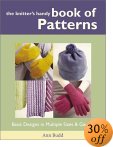 Best New Duo Best New DuoIf you read Interweave Knits, you may already be familiar with Ann Budd. The managing editor of the magazine, she's also responsible for the encyclopedic "Grand Plan" patterns. Each pattern in the series contains instructions for knitting a simple garment type in nearly any size or gauge of yarn. In the Knitter's Handy Book of Patterns, Ann expands on the "Grand Pattern" concept to cover a total of eight types of garments: mittens, gloves, hats, scarves, tams, sweaters, vests, and socks. She puts more than 350 pattern combinations at your disposal. If charts and lists don't intimidate you, then this book will be your new best friend. Pair it with a stitch pattern guide and a good technique book and you'll be set for life. Read our full review Amazon.com details 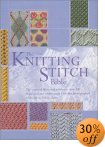 Hello, did somebody say stitch pattern guide? I have just the ticket. Hello, did somebody say stitch pattern guide? I have just the ticket.Many beginners find Barbara Walker's classic stitch books dense and overwhelming. Maria Parry-Jones' compact and colorful Knitting Stitch Bible is much more user-friendly, with most of the essentials to get any knitter started in the right direction. Two nice touches: A visual pattern index at the front of the book lets you browse patterns by image rather than by name; and a brief description of the yarn used in each pattern swatch helps you understand exactly what you see in the picture. The only potential drawbacks: Each stitch pattern is provided in chart form rather than through step-by-step instructions. Amazon.com details | |
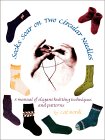 Self-Published Sock Gems Self-Published Sock GemsIf you publish it, they will come. That was Cat Bordi's philosophy when she wrote, edited, published, and promoted her book, Socks Soar on Two Circular Needles. Several follow-up books by other authors have emerged since then detailing this same technique, but Bordi's remains a classic. Her writing is a joy to follow, and the designs -- although somewhat limited -- cover a good range of aesthetic styles. Read our full review Amazon.com details 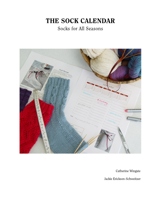 Finally, sock knitters have their own answer to Elizabeth Zimmermann's Knitter's Almanac! My second self-published gem of note is a brand new knitting calendar from Catherine Wingate and editor/designer/publisher/shop owner Jackie Erickson-Schweitzer. Finally, sock knitters have their own answer to Elizabeth Zimmermann's Knitter's Almanac! My second self-published gem of note is a brand new knitting calendar from Catherine Wingate and editor/designer/publisher/shop owner Jackie Erickson-Schweitzer.Consider this beautiful little booklet a map by which to chart your creative processes throughout the coming year. Each of the 12 sock patterns is thoughtfully matched to its month (hearts for February, red white and blue for July, etc.). The writing is clear and encouraging, and the crisp photographs show you every detail you need to see. The patterns span techniques from ribs to lace, cables, slipped stitches, and even beads, not to mention Kool Aid-dyed yarn. And if you fail to complete each sock in the first year, don't fret -- the calendar runs through 2006. Calendar details | |
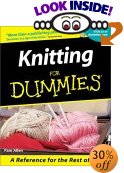  Most Unfortunate Titles Most Unfortunate TitlesHere we have a tie between Pam Allen's Knitting for Dummies and The Complete Idiot's Guide to Knitting and Crocheting by Gail Diven. Pam Allen in particular is a wonderful designer who Melanie Falick profiled in Knitting in America. Her pearls of prose deserved more prominent treatment than this. Unfortunately most readers weren't able to get beyond the "dummy" and "complete idiot" references. Read more about these books at Amazon.com: Knitting for Dummies The Complete Idiot's Guide to Knitting and Crocheting | |
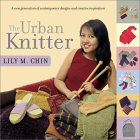 Biggest Brouhaha Biggest BrouhahaThe source of the term "Hip Young Urban Knitter" (or HYUK), this book was written by Lily Chin with the creative collaboration of so-called HYUKs from across North America. Unfortunately, in focusing so much on youth and hipness, the book alienated a lot of people. Lifelong knitters felt dismissed as passÚ simply because of their age. And even those who technically did qualify as HYUKs didn't feel welcome at the party. The book includes the now-infamous knitted bra pattern, as well as socks, shoes, a halter top, dress, and other items. The black-and-white paperback has just a few full-color glossy pages in the center depicting each garment pinned against a flat surface, rather like butterflies in a display case. Read the full review Amazon.com details | |
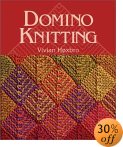 Biggest Newcomer Who Wasn't Biggest Newcomer Who Wasn'tThis year Nordic designer Vivian H°xbro became the international poster-child for domino knitting. The term "domino knitting" was dubbed by the Danish Guild of Handknitters in response to Horst Schultz's mid-1990s designs. But what many people don't realize is that this style represents only one of Vivian H°xbro's many design "oeuvres." H°xbro has also worked extensively with an innovative "shade-knitting" technique that plays on the innate texture of garter stitch. She used contrasting colors on right-side and wrong-side rows to create the illusion of added depth and shifting colors. It's a deceptively simple technique with stunning visual results. You can view many examples of it on her Web site. Amazon.com details | |
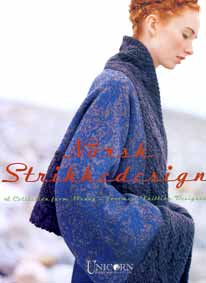 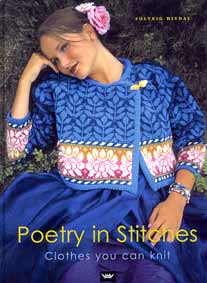 Notable Imports Most people either love or hate Nordic-inspired designs. But if you love them, start saving up for either of these books. They're sophisticated, inspiring, visually exquisite, and, alas, pricey. Norsk Strikkedesign Poetry in Stitches | |
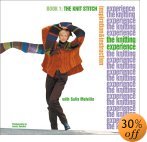 Best Back-to-Basics Best Back-to-BasicsIf I were trapped on a desert island with one other knitter, I'd want it to be Sally Melville. This special book reflects Sally's heart on every single page. The idea behind the book's series is simple: Reduce knitting to its most fundamental ingredients and dedicate an entire book to each one. In this book, the first in the series, Melville has managed to revive what many consider the most boring stitch pattern on the planet, the garter stitch. At the KR retreat, one of the attendees was wearing a sweater that was so visually sophisticated and elegant I was sure it had come from Norway, but no, it was from Melville's book. The book's success may be hindered by its late timing, just as readers are beginning to tire of the "Wow, I'm knitting!" titles. But do give it a second look, because there's great stuff under the covers. Amazon.com details | |
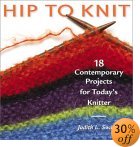 Most Misleading Title Most Misleading TitleI do wish they hadn't included the word "hip" in this book's title, because Hip to Knit is far more than just another "golly, knitting is so cool and trendy" book. Inside, it features solid foundation patterns for nearly everything you'll want to knit at the beginning: hats, caps, socks, mittens, purses and bags, tanktops, pullovers, and -- yes -- even the potentially jinxed boyfriend sweater. Each pattern assumes that you already know how to knit. The book is written by Judith Swartz, a professional knitwear designer who previously wrote Dogs in Knits. In her introduction, Swartz tells how she learned to knit from her mother and grandmother, and how knitting helps her keep that connection alive. "I still incorporate some of my mother's and grandmother's idiosyncracies into the way I knit - my method of purling and the way I wind a little ball of extra cast-on yarn," she explains. "I love the romantic idea of a craft passed down through generations much like an oral -- or perhaps tactile -- history. Whenever I'm knitting, my mother and grandmother are with me." So true. The book contains fewer patterns than the Yarn Girls' Guide to Simple Knits (18 versus 30), but with a proportionately lower cover price and no name-dropping in sight. Swartz's loving and honest voice is a pleasure to read. Amazon.com details | |
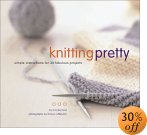 Most Accurate Title Most Accurate Title"Easy" is quickly becoming a four-letter word in knitting books these days, and this one -- a recent release from San Francisco's Chronicle Books -- teeters dangerously on the edge but never quite falls in. (The only questionable case is the rectangular garter-stitch bookmarků but I'll let you decide about that one.) Knitting Pretty has two crowning elements: First, Percival's fresh perspective and genuine enthusiasm; and second, France Ruffenach's delicious, decadent photography. The designs are all capital-e Easy, with some that may be considered odd or even unconventional. In a few cases the book would have benefited from more instructive -- rather than artful -- photographs. But overall, even if you only knit one or two items from the book, it'll make a handsome addition to your coffee table. Amazon.com details | |
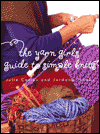 New East Coast Knitting Celebs New East Coast Knitting CelebsThe self-dubbed Yarn Girls are Julie Carles and Jordana Jacobs, and their pulpit is The Yarn Company, a high-end store they co-own in New York City. This book contains 30 of their favorite patterns for six of the most common sweater shapes: funnel-neck, crewneck, and v-neck pullovers; cardigans; tank tops; and ponchos. Also included are patterns for scarves, hats, and throws. All are extremely easy and basic, and most of them will knit up within a week or two. Depending on how much you invest in yarn for the sweater (and many of these patterns will run you over $200), you might want the knitting experience to last a little longer than that. Some readers complain about the abundance of name-dropping that goes on in this book. The irony is that the authors manage to do it all without ever revealing any names. Read our full review Amazon.com details | |
 New West Coast Knitting Celeb Not to be confused with Bill Gibb's 1987 book by the same title, Suss Cousins' book is the Hollywood cousin to the Yarn Girls' book. Only in this case, Cousins drops real names of celebrity students and customers, and has such people as Julianne Moore, Steven Weber, and Regina King model her creations. The patterns are fresh and interesting, similar in concept to the Yarn Girls' and Hip to Knit but with noticeably tighter fitting. My only wish is that the book's marketing team hadn't used the following clichÚs to describe knitting: "not just for grandmothers anymore" and "as hip and trendy as Jennifer Anniston's hairstyle." With all due respect to Ms. Anniston's hair stylist, I do hope my love of knitting lasts a little longer than her latest coiffe. Amazon.com details | |
 Best Bulletproof Book Best Bulletproof BookFinally, 20 years of Rowan under one cover! You'll find 80 patterns total from designers Kim Hargreaves, Louisa Harding, Kaffe Fassett, Debbie Bliss, Helen Dawson, Brandon Mably, Fiona McTague, Zoe Mellor, Sharon Peake, and Martin Storey. The book doesn't cover some of Rowan's most recent developments -- for example, you don't find any Rowanspun or Cork patterns here. But even so, Rowan fans may benefit from having so many patterns under one roof in the thickest, heaviest, most substantial stop-a-bullet-mid-air textbook-style collection I've yet to see. Amazon.com details | |
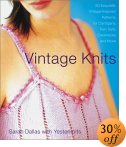 Biggest Blooper Biggest BlooperA recent controversial KnitNet editorial discredited most online knitting resources, instead urging people to stick with established book publishers "whose credibility and financial well-being are linked to the quality of the information." Yet as we discover in Vintage Knits, everyone makes mistakes, even the big guys. An excellent and long-needed book for anybody who appreciates vintage knitwear patterns, Vintage Knits has only one minor problem: The editors forgot to fill in the Fair Isle color charts. Instead, all you get are blank grids. This notwithstanding, you'll find a great number of designs (30 in all) to keep you occupied. You won't find huge bulky garments here. In keeping with the tradition of vintage patterns, most are DK weight or lighter. All patterns call for Rowan yarns. Amazon.com details | |
 Best Connection with Knitters Past Best Connection with Knitters PastMany of us enjoy the feeling of connectedness with our past that we experience when knitting. We watch our fingers make their knitting motions and - in them - we can see the hands of our foremothers. Some of us enjoy collecting old needles for this same reason. If this sounds like you, then you'll have a heyday with Laurel Thatcher Ulrich's book. In it, she attempts to trace the provenance of several ordinary household items from Colonial American times. Among the items are a spinning wheel, niddy noddy, and unfinished knitted stocking. I encourage you to read this exceptional book. Besides the fact that it's a great read and makes history come alive, it tells the seldom-told story of how the fiber arts evolved as a distinctly women's industry, and, for once, shows how fundamental they were to the nation's development. Read our full review Amazon.com details |
|
Copyright © 2000-2016 Clara H. Parkes
All rights reserved. Permission to reproduce is required.
All rights reserved. Permission to reproduce is required.
